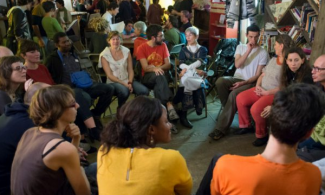
Dusting Off Distributism
In the early-to-mid-20th Century the Distributists—led by English authors G.K. Chesterton and Hillaire Belloc—took a dim view of both socialism and corporate capitalism. As conservatives they did, however, believe in private property—so much they thought it should be “distributed” as widely as possible among the whole population.
At its root, the Distributist movement sought a practical, community-oriented alternative to the inequality of capitalism and the bureaucracy of socialism. To fulfill this vision, Distributists advocated for family farms, family-run businesses, a return to craftsmanship and community self-reliance. When large enterprises were inevitable, such as industrial factories, they advocated worker-run cooperatives to give people a greater share of ownership.
Chesterton noted, “There is less difference than many suppose between the ideal socialist system, in which the big businesses are run by the state, and the present capitalist system, in which the state is run by the big businesses. They are much nearer to each other than either is to my own ideal; of breaking up the big businesses into a multitude of small businesses.”
Chesterton and Belloc excelled at writing essays, but not at organizing a political movement. Beyond several well-attended conferences and a scattering of local projects, Distributists never established a successful course toward achieving their ideals. Distributism was not adopted as an economic system in any nation, although the “Green” peasant parties of Central Europe in the 1920s and ‘30s enacted similar policies to keep people on the land.
A full-blown Distributist movement never emerged in the United States, but its ideas were embraced in the mid-20th Century by influential figures from Catholic Worker founders Dorothy Day and Peter Maurin to Bishop Fulton Sheen to historian Garry Wills. Chesterton and Belloc were guided by Catholic Social teachings, especially Pope Leo XIII whose 1891 encyclical Rerum Novarum embraced social justice as a core Catholic mission. But not all Distributists were Catholic.
The themes of Distributism continue to attract political activists, social commentators and others looking for fresh economic and cultural directions for our society. Ross Douthat, a conservative columnist for the New York Times, describes his work as being in the “Distributist tradition”.
Richard Aleman, editor-in-chief of the Distributist Review, believes the global economic crisis since 2008 means that Distributism’s message of “more ownership of the economy, more participation of the poor” is more relevant than ever.
“The problem with capitalism from a Distributist perspective,” he tells me, “is that too much ends up the hands of too few. Most people prefer Main Street to Wall Street. They want community. They want to solve problems on the local level. There’s a potential for both left and right to be Distributist”—a conviction he has voiced to conservative Catholic organizations as well as Occupy Wall Street activists.
Here’s Aleman outline for 21st Century Distributism: Local, organic food production; Mom and pop businesses; Community banking and credit unions; Microfinance programs so families around the world can start small businesses; Community self-reliance; Cooperatives and worker ownership; Farmers’ markets and community supported agriculture (CSAs); Locally based currencies; Craft and artisan guilds.
- See more at: http://onthecommons.org/magazine/conservative-case-commons-way-life#sthash.pl2V2uAZ.dpufIn the early-to-mid-20th Century the Distributists—led by English authors G.K. Chesterton and Hillaire Belloc—took a dim view of both socialism and corporate capitalism. As conservatives they did, however, believe in private property—so much they thought it should be “distributed” as widely as possible among the whole population.At its root, the Distributist movement sought a practical, community-oriented alternative to the inequality of capitalism and the bureaucracy of socialism. To fulfill this vision, Distributists advocated for family farms, family-run businesses, a return to craftsmanship and community self-reliance. When large enterprises were inevitable, such as industrial factories, they advocated worker-run cooperatives to give people a greater share of ownership.
Chesterton noted, “There is less difference than many suppose between the ideal socialist system, in which the big businesses are run by the state, and the present capitalist system, in which the state is run by the big businesses. They are much nearer to each other than either is to my own ideal; of breaking up the big businesses into a multitude of small businesses.”Chesterton and Belloc excelled at writing essays, but not at organizing a political movement. Beyond several well-attended conferences and a scattering of local projects, Distributists never established a successful course toward achieving their ideals. Distributism was not adopted as an economic system in any nation, although the “Green” peasant parties of Central Europe in the 1920s and ‘30s enacted similar policies to keep people on the land.
A full-blown Distributist movement never emerged in the United States, but its ideas were embraced in the mid-20th Century by influential figures from Catholic Worker founders Dorothy Day and Peter Maurin to Bishop Fulton Sheen to historian Garry Wills. Chesterton and Belloc were guided by Catholic Social teachings, especially Pope Leo XIII whose 1891 encyclical Rerum Novarum embraced social justice as a core Catholic mission. But not all Distributists were Catholic.The themes of Distributism continue to attract political activists, social commentators and others looking for fresh economic and cultural directions for our society. Ross Douthat, a conservative columnist for the New York Times, describes his work as being in the “Distributist tradition”.
Richard Aleman, editor-in-chief of the Distributist Review, believes the global economic crisis since 2008 means that Distributism’s message of “more ownership of the economy, more participation of the poor” is more relevant than ever.“The problem with capitalism from a Distributist perspective,” he tells me, “is that too much ends up the hands of too few. Most people prefer Main Street to Wall Street. They want community. They want to solve problems on the local level. There’s a potential for both left and right to be Distributist”—a conviction he has voiced to conservative Catholic organizations as well as Occupy Wall Street activists.
Here’s Aleman outline for 21st Century Distributism: Local, organic food production; Mom and pop businesses; Community banking and credit unions; Microfinance programs so families around the world can start small businesses; Community self-reliance; Cooperatives and worker ownership; Farmers’ markets and community supported agriculture (CSAs); Locally based currencies; Craft and artisan guilds.- See more at: http://onthecommons.org/magazine/conservative-case-commons-way-life#sthash.pl2V2uAZ.dpuf
cross-posted from On the Commons
 In the early-to-mid-20th Century the Distributists—led by English authors G.K. Chesterton and Hillaire Belloc—took a dim view of both socialism and corporate capitalism. As conservatives they did, however, believe in private property—so much they thought it should be “distributed” as widely as possible among the whole population.
In the early-to-mid-20th Century the Distributists—led by English authors G.K. Chesterton and Hillaire Belloc—took a dim view of both socialism and corporate capitalism. As conservatives they did, however, believe in private property—so much they thought it should be “distributed” as widely as possible among the whole population.
At its root, the Distributist movement sought a practical, community-oriented alternative to the inequality of capitalism and the bureaucracy of socialism. To fulfill this vision, Distributists advocated for family farms, family-run businesses, a return to craftsmanship and community self-reliance. When large enterprises were inevitable, such as industrial factories, they advocated worker-run cooperatives to give people a greater share of ownership.
Chesterton noted, “There is less difference than many suppose between the ideal socialist system, in which the big businesses are run by the state, and the present capitalist system, in which the state is run by the big businesses. They are much nearer to each other than either is to my own ideal; of breaking up the big businesses into a multitude of small businesses.”
Chesterton and Belloc excelled at writing essays, but not at organizing a political movement. Beyond several well-attended conferences and a scattering of local projects, Distributists never established a successful course toward achieving their ideals. Distributism was not adopted as an economic system in any nation, although the “Green” peasant parties of Central Europe in the 1920s and ‘30s enacted similar policies to keep people on the land.
 A full-blown Distributist movement never emerged in the United States, but its ideas were embraced in the mid-20th Century by influential figures from Catholic Worker founders Dorothy Day and Peter Maurin to Bishop Fulton Sheen to historian Garry Wills. Chesterton and Belloc were guided by Catholic Social teachings, especially Pope Leo XIII whose 1891 encyclical Rerum Novarum embraced social justice as a core Catholic mission. But not all Distributists were Catholic.
A full-blown Distributist movement never emerged in the United States, but its ideas were embraced in the mid-20th Century by influential figures from Catholic Worker founders Dorothy Day and Peter Maurin to Bishop Fulton Sheen to historian Garry Wills. Chesterton and Belloc were guided by Catholic Social teachings, especially Pope Leo XIII whose 1891 encyclical Rerum Novarum embraced social justice as a core Catholic mission. But not all Distributists were Catholic.
The themes of Distributism continue to attract political activists, social commentators and others looking for fresh economic and cultural directions for our society. Ross Douthat, a conservative columnist for the New York Times, describes his work as being in the “Distributist tradition”.
Richard Aleman, editor-in-chief of the Distributist Review, believes the global economic crisis since 2008 means that Distributism’s message of “more ownership of the economy, more participation of the poor” is more relevant than ever.
“The problem with capitalism from a Distributist perspective,” he tells me, “is that too much ends up the hands of too few. Most people prefer Main Street to Wall Street. They want community. They want to solve problems on the local level. There’s a potential for both left and right to be Distributist”—a conviction he has voiced to conservative Catholic organizations as well as Occupy Wall Street activists.
Here’s Aleman outline for 21st Century Distributism: Local, organic food production; Mom and pop businesses; Community banking and credit unions; Microfinance programs so families around the world can start small businesses; Community self-reliance; Cooperatives and worker ownership; Farmers’ markets and community supported agriculture (CSAs); Locally based currencies; Craft and artisan guilds.
[Graphics and links added by GEO]
 On the Commons is licensed under a Creative Commons Attribution-ShareAlike 3.0 Unported License.
On the Commons is licensed under a Creative Commons Attribution-ShareAlike 3.0 Unported License.





Add new comment